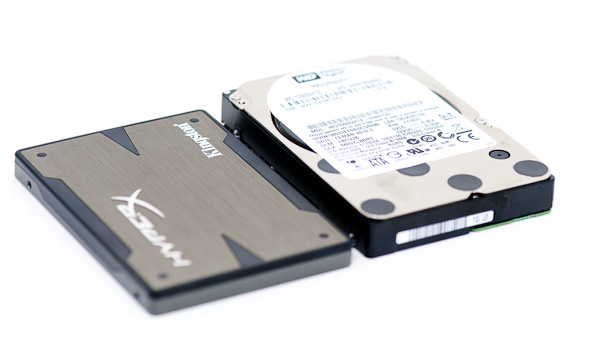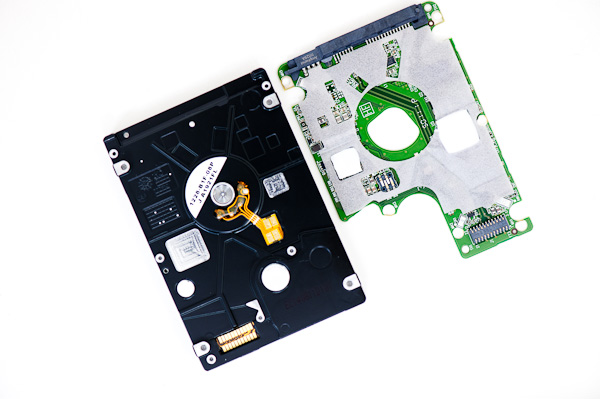Western Digital VelociRaptor 1TB (WD1000DHTZ) Review
by Anand Lal Shimpi on April 16, 2012 8:00 AM EST- Posted in
- Storage
- HDDs
- Western Digital
- VelociRaptor
Final Words
The new VelociRaptor does reclaim its title as world's fastest client hard drive, and I do appreciate the fact that WD hasn't raised prices on the drive in the past two years either. Compared to any 3.5" drive on the market today, the new VR is significantly faster without a doubt. Random IO performance is at least double most 3.5" drives, and sequential performance is almost 50% better than the fastest competitors. Most impressive is the fact that power consumption is actually competitive with modern 3.5" green drives as well, another benefit of the VR's 2.5" package.
The biggest problem for the new VR today is the same issue we had two years ago: SSDs are much faster, and are quickly becoming more affordable. As a primary drive I wouldn't recommend the VelociRaptor simply because you can get a better overall experience with an SSD. We have a number of very reliable, reasonably affordable (128GB), high-performing SSD options to choose from. Intel's lineup, Samsung's SSD 830 and Crucial's m4 all come to mind.
As secondary storage, the new VelociRaptor appeals to those users who need more capacity than an SSD can affordably offer, for active use. Launching applications, games, and working on (not just streaming for playback) large data files are all going to be quicker on the VR than on a standard 3.5" drive. If you're building the ultimate workstation, you could use an SSD + VR for internal storage coupled with some larger, slower drives in RAID as a backup or for your more passive data (movies, music, edited photos). For most users however, I'd honestly recommend an SSD plus a couple of large, 5400/7200RPM drives in RAID-1 for everything you can't store on your SSD. While the Raptor line was quickly embraced by the enthusiast, I believe it has transitioned exclusively to a workstation role.
I have to admit I was disappointed to see that Western Digital went conservative on the new VelociRaptor design and didn't include any on-board NAND to really mix things up. What I was hoping for was a combination of the VelociRaptor and Seagate's Momentus XT. Perhaps that doesn't make sense given the available SSD caching solutions available today, but I don't see the harm in pairing even a small amount of NAND with the drive. I don't see hard drives going away anytime soon, so we might as well try to make accessing them as quick as possible.
Then there's the extreme option. I would love to see a manufacturer treat a hard drive as an SSD with a mechanical counterpart, rather than a hard drive with some NAND on it. I'm curious to see what a VelociRaptor (or any other 2.5" HDD) with 64GB of NAND used as a read/write cache would behave like. If users are able to fit all of their program, apps and data into a 128GB SSD, I have to believe that a well managed cache can deliver compelling performance with half that space.
Unfortunately most hard drive companies seem slow to adopt NAND into their designs, so I suspect much of this will have to be a dream for now. The new VelociRaptor is a great evolution of the design and it's truly a very fast hard drive. Just as before, if I needed to buy a high-performance mechanical hard drive, it's the one I'd pick.












92 Comments
View All Comments
Stuka87 - Monday, April 16, 2012 - link
Seagate would disagree. As they Hybrid drives are nearly as fast as an SSD but have a terabyte of storage.kmmatney - Monday, April 16, 2012 - link
I'm pretty surprised at how far behind the Seagate Momentus XT is in these benchmarks, though. This review doesn't make the Seagate look very good at all.exordis - Monday, April 16, 2012 - link
IIRC from the Momentus XT review it's performance on the first run through of a given benchmark was basically the same as any other HDD of the same specs. Because of the way it learns common tasks and caches the things you do often it requires a couple of runs of a given task before it's extra performance shows.Samus - Monday, April 16, 2012 - link
I not only disagree as well with Makaveli, but can't help but think what a failure it is on WD's part to ignore making this drive a hybrid like the Momentus XT.Remember, the Momentus XT isn't tweaked for performance, it's an extremely low power (5-watt) drive that needs to meet the cooling envelope of a laptop drivebay.
The Raptor doesn't have those restrictions. If this drive were paired with 8 or 16GB NAND, it would have been a monster, essentially a 1TB SSD for <$400.
The problem must be WD knows nothing about hybrid technology. They can't possibly be foolish enough to ignore the fact that SSD's are the future and hard disks can't survive by only having superior capacity and lower prices. They need to have high performance and reliability as well.
This launch is a complete disaster. This could have been exceptional if adapted to the times. A 10k performance-oriented drive using Hybrid-NAND technology could have been amazing.
kyuu - Tuesday, April 17, 2012 - link
/agreeThe only problem is that they'd have been starting from scratch with the caching algorithms and other things that go along with a hybrid HDD. Remember how much of a disaster Seagate's 1st gen hybrid HDDs were? Part of what makes the Momentus XT great is the experience Seagate has with the hybrid HDD platform, which no other manufacturer really has.
TeXWiller - Tuesday, April 17, 2012 - link
I'd prefer to keep those SSD caches directly attached to the PCIe bus and have a more knowledgeable operating system.The reliability numbers are quite good, so on paper this would be the most reliable 1 TB consumer oriented rotating hard drive. This way the launch is not a disaster as drives with equivalent theoretical reliability are hard, or much more expensive to buy from the online store near you.
Samus - Tuesday, April 17, 2012 - link
I've replaced a number of Raptors through almost every generation in mail servers and SQL servers that receive a lot of constant traffic within warranty.That would never happen with an SSD, where you can do 20GB/day for 5+ years.
mercutiouk - Tuesday, April 17, 2012 - link
One thing you COULD do with this is throw it in the intel rapid storage raid 5 setup. Sit the fastest 40GB SSD you can find (or a partition of a larger SSD of course) with 4 of these behind it.While not cheap (you'd need to drop about 1k on your storage alone) you'd be looking at 3TB of "rather quick" storage that could suffer a drive failure and keep things together.
4x 200MB sustained (so about 550/600MB once the raid 5 etc has dampened performance a bit) with an SSD doing all the responsive bits of access the raid had to deal with would make an impressive setup.
I run a hardware raid-5 with an SSD for boot at the moment and it's rather nice for most things.
GreenEnergy - Monday, April 16, 2012 - link
Microsoft actually got a fine picture on my HDs are such a huge bottleneck in todays PCs.http://blogs.msdn.com/blogfiles/e7/WindowsLiveWrit...
glasspelican - Monday, April 16, 2012 - link
I am supprised that thy dont have any flash on this drive. I got the momnentus xt in my laptop and it makes a huge difference